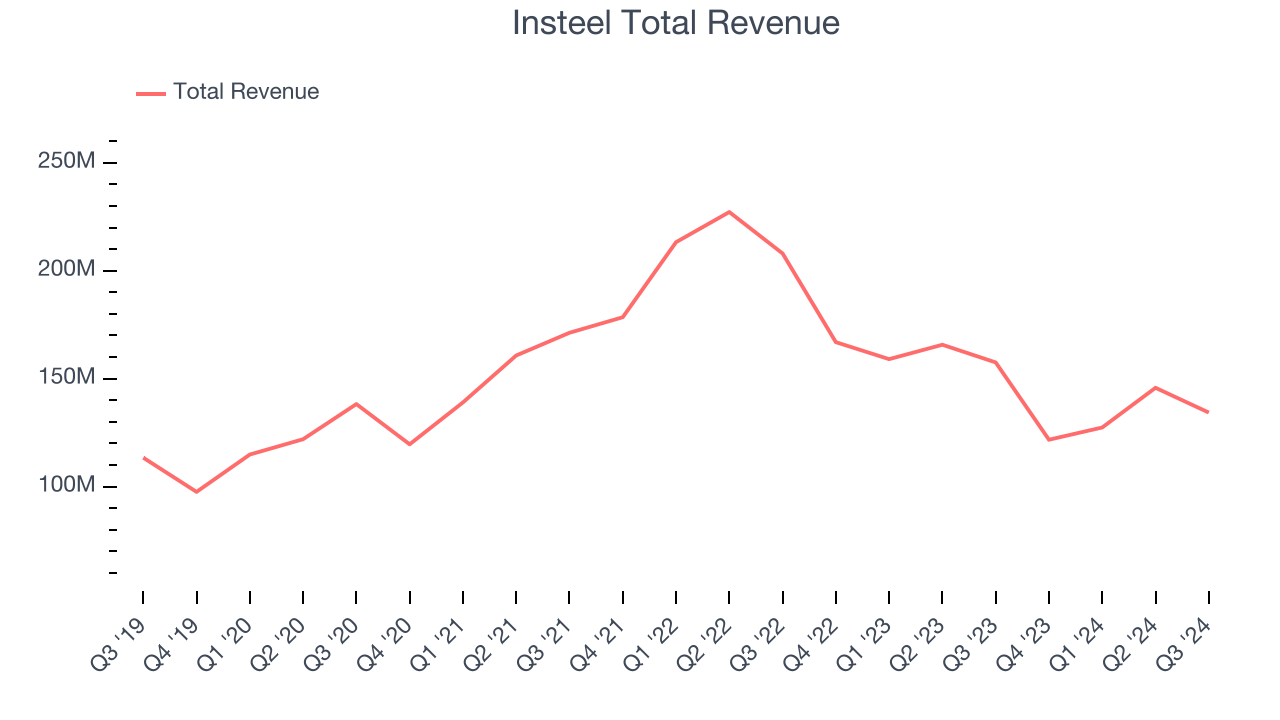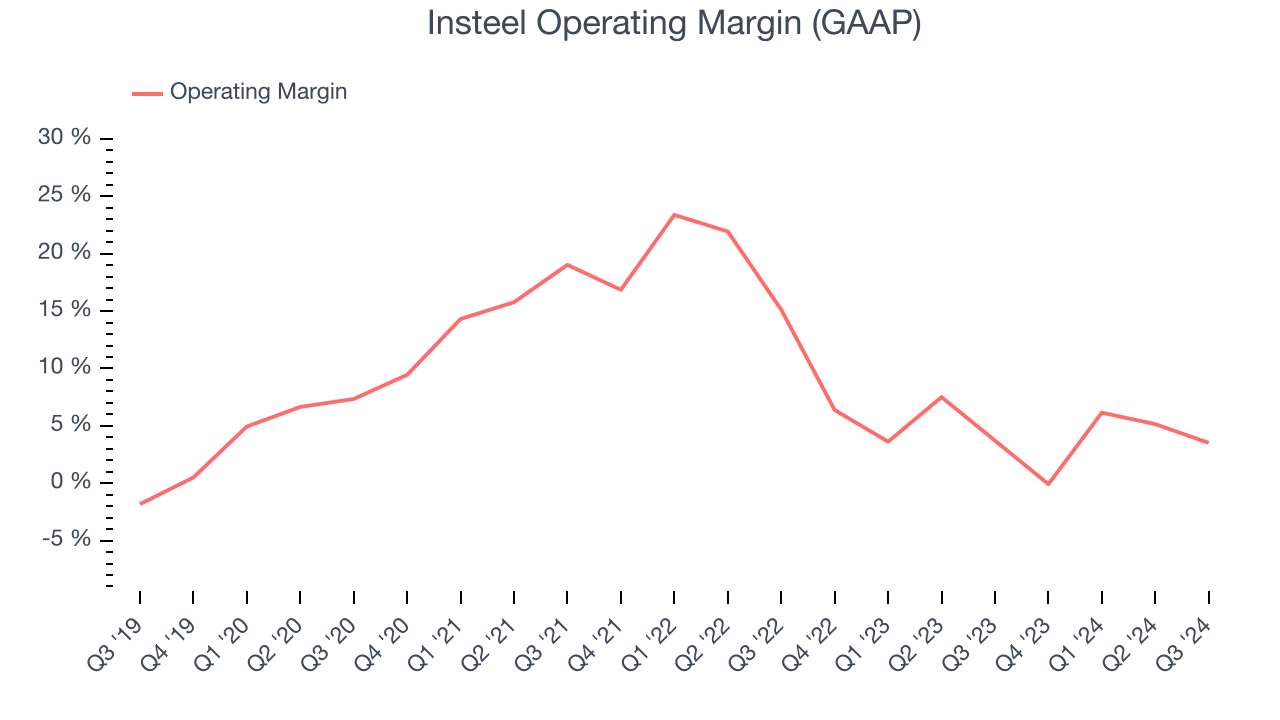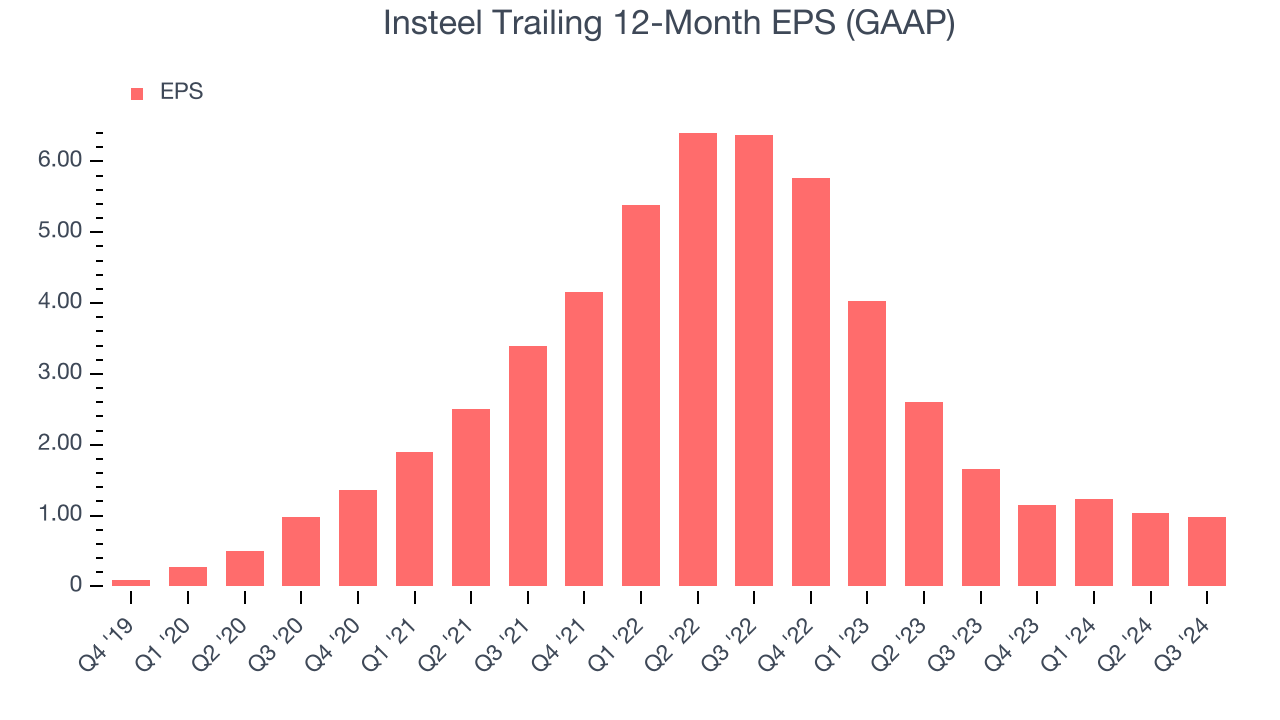Steel wire manufacturer Insteel (NYSE:IIIN) fell short of the market’s revenue expectations in Q3 CY2024, with sales falling 14.7% year on year to $134.3 million. Its GAAP profit of $0.24 per share was also 22.6% below analysts’ consensus estimates.
Is now the time to buy Insteel? Find out by accessing our full research report, it’s free.
Insteel (IIIN) Q3 CY2024 Highlights:
- Revenue: $134.3 million vs analyst estimates of $145.2 million (7.5% miss)
- EPS: $0.24 vs analyst expectations of $0.31 (22.6% miss)
- “As we move forward into fiscal year 2025, we anticipate a gradual improvement in business conditions across our markets,”
- Gross Margin (GAAP): 9.1%, in line with the same quarter last year
- Free Cash Flow Margin: 10.8%, down from 22.1% in the same quarter last year
- Market Capitalization: $573.6 million
“As we move forward into fiscal year 2025, we anticipate a gradual improvement in business conditions across our markets,” commented H.O. Woltz III, Insteel’s President and CEO.
Company Overview
Growing from a small wire manufacturer to one of the largest in the U.S., Insteel (NYSE:IIIN) provides steel wire reinforcing products for concrete.
Commercial Building Products
Commercial building products companies, which often serve more complicated projects, can supplement their core business with higher-margin installation and consulting services revenues. More recently, advances to address labor availability and job site productivity have spurred innovation. Additionally, companies in the space that can produce more energy-efficient materials have opportunities to take share. However, these companies are at the whim of commercial construction volumes, which tend to be cyclical and can be impacted heavily by economic factors such as interest rates. Additionally, the costs of raw materials can be driven by a myriad of worldwide factors and greatly influence the profitability of commercial building products companies.
Sales Growth
A company’s long-term performance is an indicator of its overall business quality. While any business can experience short-term success, top-performing ones enjoy sustained growth for multiple years. Over the last five years, Insteel grew its sales at a sluggish 3% compounded annual growth rate. This shows it failed to expand in any major way and is a rough starting point for our analysis.

We at StockStory place the most emphasis on long-term growth, but within industrials, a half-decade historical view may miss cycles, industry trends, or a company capitalizing on catalysts such as a new contract win or a successful product line. Insteel’s history shows it grew in the past but relinquished its gains over the last two years, as its revenue fell by 20% annually. Insteel isn’t alone in its struggles as the Commercial Building Products industry experienced a cyclical downturn, with many similar businesses seeing lower sales at this time.
This quarter, Insteel missed Wall Street’s estimates and reported a rather uninspiring 14.7% year-on-year revenue decline, generating $134.3 million of revenue.
Looking ahead, sell-side analysts expect revenue to grow 9% over the next 12 months, an acceleration versus the last two years. This projection is above-average for the sector and shows the market believes its newer products and services will fuel higher growth rates.
Here at StockStory, we certainly understand the potential of thematic investing. Diverse winners from Microsoft (MSFT) to Alphabet (GOOG), Coca-Cola (KO) to Monster Beverage (MNST) could all have been identified as promising growth stories with a megatrend driving the growth. So, in that spirit, we’ve identified a relatively under-the-radar profitable growth stock benefitting from the rise of AI, available to you FREE via this link.
Operating Margin
Insteel has managed its cost base well over the last five years. It demonstrated solid profitability for an industrials business, producing an average operating margin of 10.7%. This result was particularly impressive because of its low gross margin, which is mostly a factor of what it sells and takes huge shifts to move meaningfully. Companies have more control over their operating margins, and it’s a show of well-managed operations if they’re high when gross margins are low.
Analyzing the trend in its profitability, Insteel’s annual operating margin decreased by 1.4 percentage points over the last five years. Even though its margin is still high, shareholders will want to see Insteel become more profitable in the future.

This quarter, Insteel generated an operating profit margin of 3.5%, in line with the same quarter last year. This indicates the company’s cost structure has recently been stable.
Earnings Per Share
Analyzing long-term revenue trends tells us about a company’s historical growth, but the long-term change in its earnings per share (EPS) points to the profitability of that growth – for example, a company could inflate its sales through excessive spending on advertising and promotions.
Insteel’s EPS grew at an astounding 68.5% compounded annual growth rate over the last five years, higher than its 3% annualized revenue growth. However, this alone doesn’t tell us much about its day-to-day operations because its operating margin didn’t expand.

Like with revenue, we analyze EPS over a shorter period to see if we are missing a change in the business. Insteel’s two-year annual EPS declines of 60.7% were bad and lower than its two-year revenue performance.
In Q3, Insteel reported EPS at $0.24, down from $0.29 in the same quarter last year. This print missed analysts’ estimates, but we care more about long-term EPS growth than short-term movements. Over the next 12 months, Wall Street expects Insteel’s full-year EPS of $0.98 to grow by 106%.
Key Takeaways from Insteel’s Q3 Results
We struggled to find many strong positives in these results. Its revenue unfortunately missed and its EPS fell short of Wall Street’s estimates. Overall, this was a mediocre quarter. The stock traded down 10.4% to $26.43 immediately following the results.
Insteel didn’t show it’s best hand this quarter, but does that create an opportunity to buy the stock right now?If you’re making that decision, you should consider the bigger picture of valuation, business qualities, as well as the latest earnings.We cover that in our actionable full research report which you can read here, it’s free.
